While at Threadneedle Street in Issaquah, Washinton, I picked up a new book on hand embroidered monograms that is more than just a book on hand embroidered monograms – it is a fascinating glance into the House of Malbranche, a French institution dedicated, since the mid-1800’s, to the creation of beautiful household linens.
Letters and Monograms from the House of Malbranche by Yvonne Van de Velde-Malbranche and Christine Rosenthal is a hard-bound book that contains practical information for the embroiderer – instructions on creating beautiful monograms for household linens – as well as a unique look into an interesting part of textile history: the established “institutions” or “houses” that produced luxury embroidered goods for the rich and the royal.
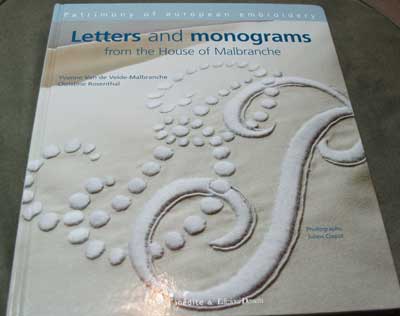
The text of the book is presented in three languages: French, Italian, and English. The book begins with a history of the House of Malbranche, detailing how the insitute would fulfill orders for custom linens – from the consulting stage, to the designing, to the distribution to embroiderers, to collections and payments.
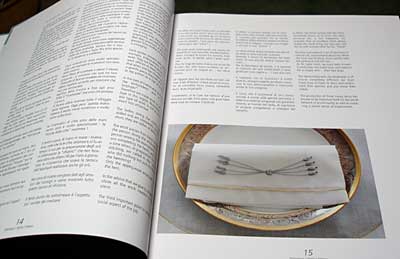
It then progresses to practical information about the embellishment of fine household linens, including embroidering to appliquéing linens for the home.
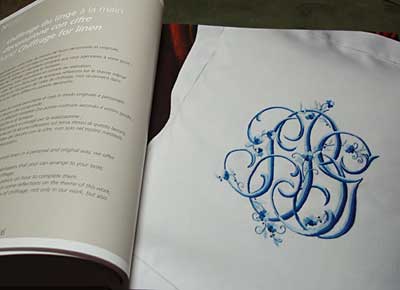
The monograms featured range from elaborate in form – scrolly, intricate letters entwined around each other – to simple, clear individual letters.
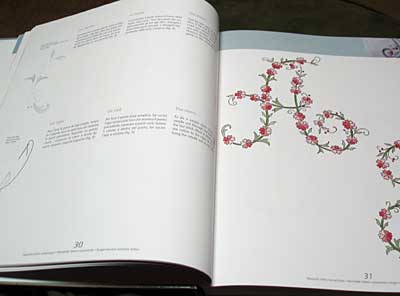
Technical information on completing the monograms is arranged alongside the photo samples included.
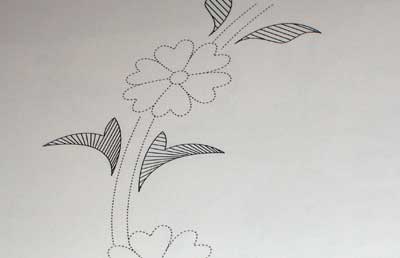
Along with patterns, detailed explanations of stitch direction (especially for satin stitching) are included. This type of information is of great help to the beginner who desires to achieve perfect satin stitching around the curves of graceful letters.
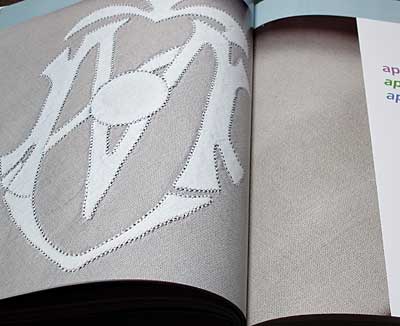
Appliqué and pin stitching are featured on a “modern” looking monogram – quite art nouveau-ish – worked in white on natural linen. Not only do I love the combination of white-on-natural, but I love the clean look of this monogram set!
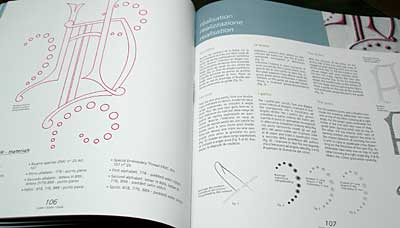
Diagrams covering different technical aspects of the art of embroidered monograms pepper the book, helping to illustrate the instructions in the text.
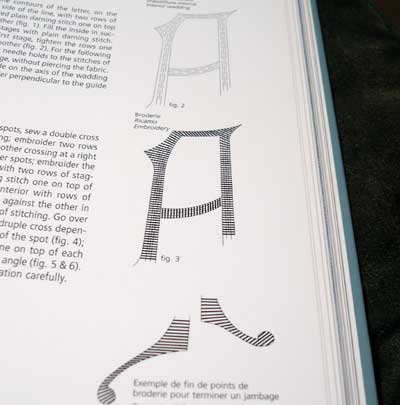
One of the most helpful topics in the technical instructions is the stitch direction for satin stitching, as mentioned above. Here, you can see that stitch direction on rounded tips of letters is being discussed and drawn out.
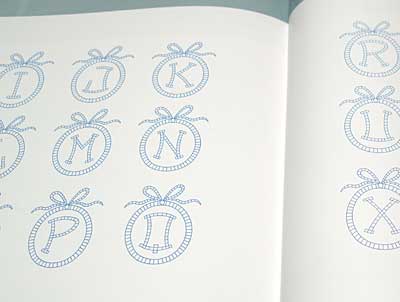
Throughout the book, there are many beautiful alphabets suitable for a variety of interpretations.
If you’re interested in whitework, in monogramming, or in the history of textiles, I think you would enjoy this book! The English translation is a little choppy here and there, but the wealth of information and beauty within the pages makes up for this.
I found the book at Threadneedle Street in Washington, but I do not know if they still have it available, as it isn’t presently on their website. They can probably order it for you, if you’re interested in it. Note, though, that the price tag was pretty hefty – around $50.
You can also find the book through Mad Sampler Books, available for special order at $48. I couldn’t find it in too many other places online, so if you happen to know a resource, do please feel free to let us know!
I think, overall, this is my favorite purchase from my recent road trip. I picked up a lot of fun things, but this was a nice find of a not-so-common book, on a topic I like, in a beautiful format, with an interesting story to read. I really like it!







This is a truly beautiful book. Thanks for bringing it to our attention!
Hello Mary, a slightly belated 'Welcome home@.
It sounds as if you have had a wonderful trip. It must have been lovely to spend so much time with your parents also, retracing the steps of ther life together.
I've been following your travels, and your reviews. I also appreciate the that you and your guest writers kept us entertained buring your break.
But it's great to have you back 🙂
I just saw this book while in Paris and found it to be exquisite! Unfortunately, I had to pass it up because it was a bit heavy to carry back!
Ashley
This looks like a great book and the illustrations look real good. Thank you for bringing all the new books, blogs and stitchery to our attention.
Mary,
Thank you for the excellent review on this book. I must look out for it in Oz. It looks to be a must have for those of us who love whitework. Great to hear about your travels.
Elspeth.
Mary ……..I especially like the "floral" letter "A". I could see doing pillow cases as Christmas gifts for my family, spelling out the whole last name. I, too, did a "round trip" to the West Coast some time ago, taking the southern route to Calif. and the northern return route to Pittsburgh. A trip you remember for a lifetime. It's really a beautiful country we are blessed to live in……Judy in Pittsburgh
Mary,
I enjoyed your book review and I would love to have this book. I'll have to start shopping around for the best price. I too enjoyed hearing about your travels, but Mary where is the Port wine from the Napa Valley? I am still waiting for my bottle 🙂 A big toast to you on a very successful trip and thanks for sharing your adventures with us.
Maria in Kansas
The book is lovely. Thank you for sharing it. Since I probably won't ever have a copy, I'm sure you can share some of the outstanding tips they give as you show us YOUR beautiful embroidery, Mary!
Thank you for sharing the book with us. This is really a beautiful book!
That is a gorgeous book, Mary! I love ThreadneedleStreet. Used to be my haunt when i lived in Renton. I miss it. You remind me that I need to place an order for Appleton Crewel wool and linen twill from them — I keep forgetting to call! That timezone difference really messes me up…
~Romilly
P.S. Don't miss the giveaway on my blog – only a couple days left!
One of the very first embroidery jobs I did (about 2 years ago now?) was to monogram 3 handkerchiefs for a friend.
I followed Theresa Dillmonte, had no idea about satin stitching and did 3 terrible jobs.
One day, when this book is less exxy, I'll buy it and do him 3 *beautiful* hankies
Hello Mary,:) I've been lurking on your website for a while now and wanted to say thank you for all the wonderful information you've put out on the net for us!
..but I also have a question..I've purchased Letters and Monogramms too and I am having some difficulty transferring detailed designs onto a corser, thicker linen (moderately see through if I hold up infront of a sunny window) so when I'm using carbon and trace my desings, it takes ages and the small details doesn't copy well either.
I've read this at the "Tracing" section of the above book: "Copy the letter precisely onto very fine tracing paper. Trace onto the fabric with the help of an embroidery pencil (the type that you find in a haberdashery)." I don't really understand how this works..would you let me know if you have a little bit of time? I'd also love to hear your suggestion on what would be the easiest way to copy detailed desings onto moderately thick, slightly coars linen. I'd really appriciate your advice!
..and thank you in advance! Ivett
Hi, Ivett –
I always find using a pencil difficult on coarse linen, as the bumpy surface is difficult to get a smooth line on with a sharp pencil. In such cases, I find pens a lot easier to use, but the difficulty is finding a pen that will wash out.
When you trace, the ideal is to have a light source directly behind your pattern and your linen.
If you're using a window, you'd tape your pattern to the window, then your linen over it, then trace it. The same concept holds true if you're using a light box – tape down the pattern, then either tape the linen or pin the linen onto the pattern, then trace.
With heavier linens, they're more difficult to see through, even when they are white, but it still can be done – I've done it with Kingston, and even with twill.
Now, depending on what type of thread you are using and what type of stitches you are using, you might be able to use a micron art pen in the finest size (.005) and trace the design – but I only suggest this if you are planning to cover completely your transfer lines, as the micron pens are permanent. You have to be very confident that your design is exactly as you want it, too! It's difficult to make changes once you've inked a design in with permanent pen!
Other suggestions: they make water-soluble transfer pens that are sold in the notions department at sewing stores. An "fine tipped" one would work ok for getting in details, as long as you can see them while you are tracing. Personally, I don't like these pens, but they do work ok, and in a pinch, they are better than nothing!
Another option: trace the design onto a light tracing paper or tissue paper, and then tack the paper onto your fabric, squaring it up where you want the design. Then, stitch over the design with running stitches to mark in your design. It's helpful if you can do this in the same color thread as the thread you intend to embroider with (that way, if you don't get all the tacking stitches out, they don't show up – or you can just stitch right on top of them, and not bother removing them at all). You can see a short tutorial on this method here:
Using tracing paper and tacking stitches to transfer a design
Do take time to read the comments at the end of the article – several readers contributed some excellent tips on how to do this method well. And it does work really well for details.
Another reader sent me an e-mail not too long ago, suggesting the use of the Papermate Flair Ultra Fine marker, in green, to transfer designs (by tracing them). She said the ink comes out completely after soaking. Now, I haven't tried this method yet, and I wonder exactly how well it would work on white fabric with white threads – I'm planning to do a little test run of it soon. But if it does work, it'd be nice, since the line would be easy enough to see, the pen is fine tipped, which is great for detail, and you don't have to worry about the design smudging away, as often happens with pencils. So we'll see how the test goes!
My recommendation: try the tracing paper and tacking stitches method, after reading the article at the link above and everyone's comments. You might find it works really well for what you want to do!
Good luck – let me know how it goes!
Best,
Mary
Dear Mary,
You have simply made my year after I found your blog and website last evening while I was searching the internet for the hand embroidery term "trailing". Many times over recent years I have searched for monogramming information but did not find anything. Last evening when I found your website and how you talk about your passion for monogramming I was so excited! There is nothing more stunning in hand embroidery than the antique monogramming. I am also a machine embroiderer but machine work will never ever replace hand work in monogramming. Since you offer these wonderful free designs I can now finally work on my stitching technique and maybe finish a beautiful monogram like those you have done. Thank you ever so much for sharing your knowledge and using your time to teach those you have never met. The internet is a wonderful source for learning. I do want this book though! 🙂 Thanks!
Beverly
Hi, Mary. I just saw this book on Hedgehog Handworks website. They list it at $48.00.
I am unable to find an english copy of this book. Does anyone wish to sell their? Know where I could get one or could anyone supply me with the the ISBN# for the english copy? Thank you.
Here’s an idea: People have trouble transferring to cloth. There is very light interfacing that behaves a little like paper. Cut an A4 size of this and feed through your printer. (take out all the paper out first and say a prayer) The interfacing should be between 80gsm and 120gsm. Most printers take this. Now let it sit and warm up while you scan the design and size up on photoshop or other. Then (say another prayer) and print.
Iron on the right side of your design. I do an outline digitised on my bernina to hold it in place and tear off the excess. Then hand embroider the rest. The bits in between (the inside of an o or p for example, will fall out by themselves as you work on it. I hope this helps
hi there
Can you give me any advice on how to find more information about the courses that are run by Maison Malbranche?
THankyou
Cathrine
Hi, Cathrine – You might try looking up Marie Yolande online (she runs needlework tours to Europe) and see if she can point you in the right direction. ~MC
Hi. At the risk of sounding a bit thick, lol., Can someone tell me, please, is crewel embroidery the same as candlewicking?
I do lots of x st., and have become interested in embroidery, candlewicking and hardanger.
Thanks in advance for any help.
Hi, there! No, candle wicking is traditionally done with a white or natural matte thread, the designs usually incorporate lots of French knots and line stitches. Crewel embroidery is done with wool, is very colorful, and employs lots of different stitches, including shaded fillings and so forth. Hope that helps! – MC
Could you please send me the price of this book
Thank you
KATHY Cole
Hi, Kathy – I don’t actually sell books on Needle ‘n Thread – I just write the reviews. You can probably find it by searching online, though…. -MC
I just bought a copy of this on the French Amazon (www.amazon.fr)
I don’t speak French but if you buy from Amazon in the US you will be able to figure it out. You can use your US Amazon password and your credit card info will come up on the French site.
I am looking for a good book that covers padded stitch embroidery specifically monograms but anything on padded satin etc would be great..can you recommend a good book?
There’s a book called Monograms: The Art of Embroidered Lettering by Susan O’Connor – it’s the best for how-to information!